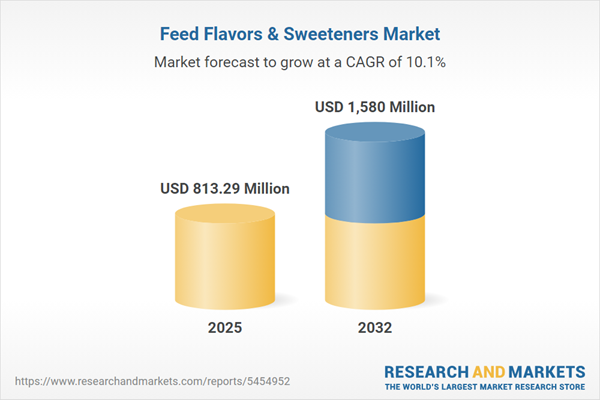Speak directly to the analyst to clarify any post sales queries you may have.
The feed flavors and sweeteners market is undergoing swift transformation as industry players adjust to evolving demands for customization, regulatory adherence, and operational agility. Leaders in the sector realize that providing tailored, transparent feed solutions is critical for sustaining value in a globally complex landscape.
Market Snapshot: Feed Flavors & Sweeteners Market Growth and Outlook
The Feed Flavors & Sweeteners Market is set for substantial expansion, with forecasts indicating growth from USD 737.51 million in 2024 to USD 813.29 million in 2025 and reaching USD 1.58 billion by 2032, representing a strong compound annual growth rate (CAGR) of 10.05%. This upward trajectory is supported by industry initiatives targeting enhanced feed palatability and refined nutritional customization across livestock, aquaculture, and companion animal segments. Businesses in the sector are prioritizing competitive innovation, leveraging local adaptation, and dynamically adjusting to both rapid regulatory changes and shifting regional requirements. These strategies foster greater portfolio diversity and agile operating models, redefining key execution standards within the feed flavors and sweeteners market.
Scope & Segmentation in the Feed Flavors and Sweeteners Market
- Sweetener Types: High-intensity sweeteners such as aspartame, saccharin, and sucralose offer versatile formulation possibilities. Plant-based alternatives like stevia and monk fruit support natural, clean-label product positioning, while polyols including sorbitol and xylitol, along with traditional sugars, allow precise nutritional adjustment and enhanced animal health outcomes.
- Sources: Feed additives are derived from animal ingredients such as dairy and fish, an array of botanical extracts from fruits, vegetables, and spices, as well as synthetic options produced via fermentation or chemical synthesis. This diversified sourcing portfolio helps manufacturers respond rapidly to market shifts and regulatory requirements.
- Form Factors: Available as liquid concentrates, emulsions, spray-dried or spray-chilled powders, oleoresins, and essential oils, these products can be seamlessly integrated within diverse feed manufacturing environments. The range of physical formats enables feed manufacturers to meet needs related to efficiency, storage, and animal wellness objectives.
- Distribution Channels: Products reach market through direct sales, distributor networks, and established digital marketplaces. These accessible channels facilitate fast responses to procurement changes and expanding customer requirements.
- Regions: The global marketplace includes the Americas, Europe, Middle East & Africa, and Asia-Pacific. Markets such as China, India, and Japan present specific compliance requirements, making locally refined business strategies essential for regulatory alignment and cross-border partnerships.
- Key Companies: Leading organizations such as Archer Daniels Midland Company, Cargill Incorporated, International Flavors & Fragrances Inc., BASF SE, DuPont de Nemours Inc., Koninklijke DSM N.V., Kemin Industries Inc., Pancosma S.A., Orffa Additives B.V., and Biochem Zusatzstoffe Handels- und Produktionsgesellschaft mbH emphasize robust supply chains and product innovation to address shifting market conditions and emerging challenges.
Key Takeaways for Senior Decision-Makers
- Customized blends of feed flavors and sweeteners enable rapid adaptation to the specific nutritional and sensory preferences of different animal species, supporting improved productivity and overall performance.
- The increasing emphasis on clean-label and natural ingredients encourages stronger supplier collaboration and enhanced supply chain transparency, especially as consumer and regulatory expectations shift.
- Technological solutions such as microencapsulation and advanced delivery systems are supporting greater additive stability and palatability, promoting reliable feed intake and reinforcing animal wellness outcomes.
- Digitization is accelerating traceability and precision nutrition, granting real-time visibility and helping to streamline supply chains while driving sustainability progress.
- Regional sourcing diversification is becoming central to mitigating supply risks and maintaining business continuity amid regulatory uncertainties.
- Established companies are broadening their strategic approaches to manage rising market complexity, ensuring continued readiness for changing regulatory and customer needs.
Tariff Impact: Navigating US Trade Policies
Recent US-imposed tariffs have created new complexities in global sourcing and supply chain reliability for the feed flavors and sweeteners sector. Leading market participants are proactively extending sourcing options, building stronger networks with nearshore suppliers, and restructuring supply contracts to preserve continuous product flow. These adaptations emphasize ongoing innovation and compliance, helping companies deliver dependable service and maintain agility despite fluctuating trade conditions.
Methodology & Data Sources
This report draws from executive interviews, in-depth regulatory reviews, proprietary datasets, and published peer-reviewed studies. Comprehensive evaluation by industry experts ensures actionable insights to support informed strategic decision-making and operational planning.
Why This Report Matters
- Strategic segmentation and targeted go-to-market insights empower executives to drive sustained growth across both global and regional markets.
- Risk management guidance and practical compliance frameworks help businesses build resilience as market and regulatory uncertainty intensifies.
- Forward-looking analysis equips decision-makers to secure a competitive advantage in an environment of evolving customer and compliance expectations.
Conclusion
Long-term success in the feed flavors and sweeteners market will depend on continuous innovation, proactive supply chain management, and strategies tailored to regional market demands.
Additional Product Information:
- Purchase of this report includes 1 year online access with quarterly updates.
- This report can be updated on request. Please contact our Customer Experience team using the Ask a Question widget on our website.
Table of Contents
3. Executive Summary
4. Market Overview
7. Cumulative Impact of Artificial Intelligence 2025
Companies Mentioned
The companies profiled in this Feed Flavors & Sweeteners market report include:- Archer Daniels Midland Company
- Cargill, Incorporated
- International Flavors & Fragrances Inc.
- BASF SE
- DuPont de Nemours, Inc.
- Koninklijke DSM N.V.
- Kemin Industries, Inc.
- Pancosma S.A.
- Orffa Additives B.V.
- Biochem Zusatzstoffe Handels- und Produktionsgesellschaft mbH
Table Information
| Report Attribute | Details |
|---|---|
| No. of Pages | 196 |
| Published | November 2025 |
| Forecast Period | 2025 - 2032 |
| Estimated Market Value ( USD | $ 813.29 Million |
| Forecasted Market Value ( USD | $ 1580 Million |
| Compound Annual Growth Rate | 10.0% |
| Regions Covered | Global |
| No. of Companies Mentioned | 11 |









